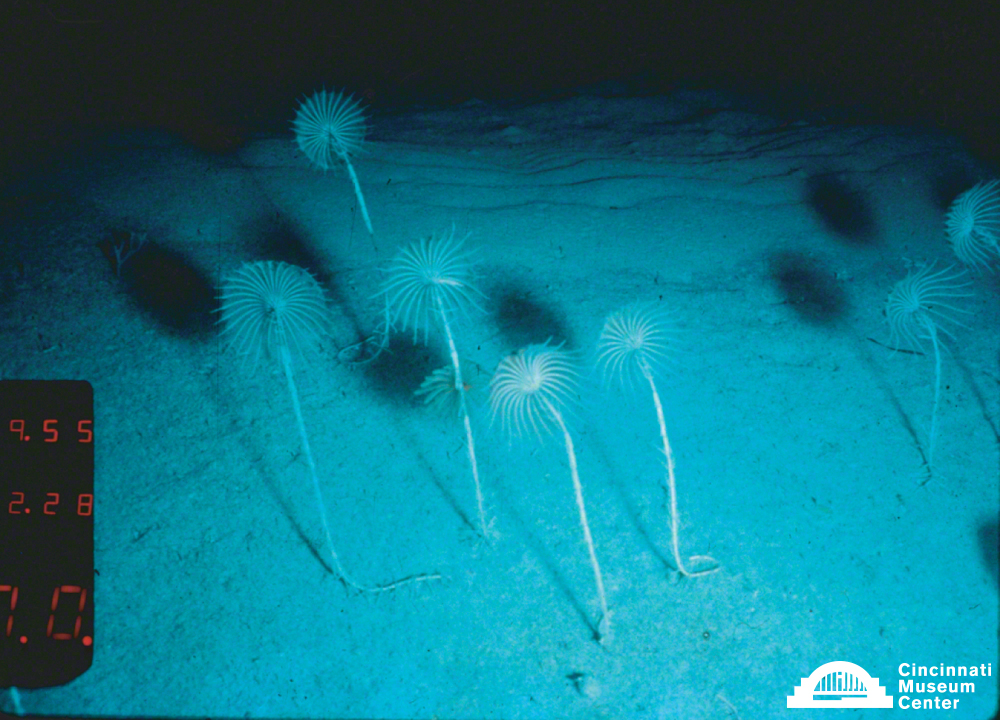
CMC Blog
A World-Class Crinoid Fossil Assemblage
By: Brenda Hunda, Curator of Invertebrate Paleontology

A close-up view of a portion of the slab after preparation. Over 500 Glyptocrinus decadactylus specimens were revealed. Note the exceptional preservation of these specimens. The pinnules on the arms are intact, as is the stem. Modern actualistic studies of echinoderm decay on the seafloor indicate that rapid burial would have had to occur within hours to days of the death of these animals for this exceptional preservation to occur.
This slab is covered with complete and nearly complete specimens of one species of crinoid, Glyptocrinus decadactylus, and is one of the largest and most spectacular examples of fossil crinoid preservation ever found in the Cincinnatian Series (Late Ordovician Period, 450 million years ago). These animals were very diverse and numerous in the Ordovician and are one of the most sought after fossils in our local Cincinnatian deposits. The exquisite preservation of these crinoids could happen only if a living population were buried rapidly by a smothering blanket of fine sediment, probably resulting from a turbidity flow on the seafloor triggered by a storm or seismic shock. If not rapidly buried, crinoids usually break up into numerous small fragments after death.
This type of fossil preservation has high fidelity - preserving a “snapshot” of life as it existed on the ocean floor. The crinoids probably lived in a dense patch on the seafloor where they attached to algae and stalks of other crinoids at a depth of tens of meters. The feathery "arms" of the crinoids spread out to intercept bottom currents carrying suspended food particles.
Rare specimens like this one provide paleontologists a window into the population dynamics, paleobiology, and paleoecology of these organisms at an extremely high temporal resolution in the fossil record. This is exceptional for fossils that are 450 million years old and is one of the reasons that our rocks and fossils are world-famous.

Image of general crinoid morphology (a) and life position (b). Modified after Clarkson (1998).
A joint venture for scientific advacement
You don’t have to be a professional paleontologist to make world-class fossil discoveries in the Cincinnatian. Amateur fossil collectors have made many major contributions. A local fossil collector discovered this 4’ x 7’ crinoid slab near Maysville, Kentucky. A layer of mudstone obscured the fossils on the surface of the slabs and only after many hours of skilled and painstaking preparation using air abrasive and small pneumatic tools could the crinoids be exposed in relief.
This assemblage was made available for scientific study through a generous donation to Cincinnati Museum Center’s Invertebrate Paleontology Collection. Scientific knowledge of our natural heritage has benefited from a unique collaboration between professionals and amateurs in this region.

The fossil slab before preparation. Except for a few crinoid pieces visible at the surface, there is little indication of the number of exceptional crinoid specimens within it.

Deep sea image showing what these crinoids would have looked like in life position on the sea floor. The number of specimens in the fossil slab indicates that this would have been a denser accumulation of animals than seen here. Photo taken by Charles G. Messing.
Museum Admission
Includes Cincinnati History Museum, Museum of Natural History & Science and The Children’s Museum.
| Adult (13+): | |
| Senior (60+): | |
| Child (3-12): | |
| Member Adult: | FREE |
| Member Child: | FREE |
Members receive discounts!
Become a Member today to save on programs, exhibits and films throughout CMC.
Museum Hours
Open Thursday – Monday
10 a.m. to 5 p.m.
Closed Tuesday and Wednesday
Closed Thanksgiving Day and Christmas Day
Member’s-only early entry: Saturdays at 9 a.m.
Customer Service Hours:
Monday – Sunday, 9 a.m. to 5 p.m.



